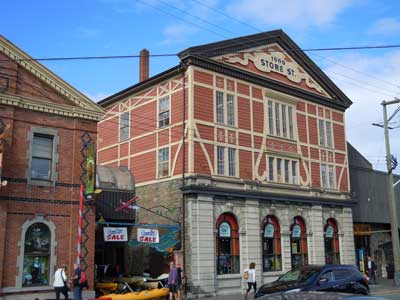Heritage Register
Downtown
1900 Store Street
Capital Iron
Built
1862
Heritage-Registered/Commercial
For: Dickson, Campbell & Company

ARCHITECTURE:
This is a 3-storey, front-gabled, stone and wood frame commercial building. The main floor is of sandstone parged to replicate the original rusticated block design. There are four large arched windows with four pilasters joined by a simple sheetmetal dentil cornice. The upper two storeys are of wood frame construction with three bays of multi-paned windows set in horizontal cove siding with a half-timbered overlay including scrolls and quatrefoil panels. The pedimented gable has sheetmetal dentilled cornices. The upper sides continue the siding and half-timbered treatment, but simpler and have regularly-spaced, multi-paned, double-hung sashes. The lower sides are of rubble stone masonry. Added to the right side is a large late 20th Century addition dominated by a wide band of vertically grooved metal siding. The sloping site allows a view from the harbour of all four storeys including the basement, which has a central entrance with a pair of arched windows on either side. The rear of the main floor has a pair of arched windows on either side of a larger central arched opening. It is built of dressed sandstone with quoined corners and openings plus prominent keystones. The upper two storeys are a simpler version of the front. On the main floor some openings are partially shut with concrete blocks.
ORIGINAL OCCUPANTS:
Now a favourite shopping destination, this masonry building dates from 1862. It was built for Dickson, Campbell & Co, Commission Agents. The British Colonist of May 20, 1867 describes the owners as having “bonded their stone warehouse. Bonded goods will be stored at the rate of 3 bits per ton per month.” The Mount Royal Milling and Manufacturing Co of Montreal leased the building in 1885 and built a 2-storey addition above the back half on the harbour side of the building. This was a boiler and engine house with a detached chimney, and rice milling machinery was installed. It operated as the Victoria Roller Flour and Rice Mill with rice brought in from Thailand, Vietnam and China by the company-owned clipper ship Thermopylae.
By 1891 the familiar front gable decoration had been added to the upper storeys and the brick building at 1824 Store St was erected around the same time. Both buildings were used in the rice and flour mill trade until 1923.
OTHER OCCUPANTS:
The building housed a number of short-term tenants from that point and it sat empty from 1932 to 1934, when Morris L. Greene rented space in both buildings and later purchased them from the Montreal owners. Greene, born in 1900, was the son of a New York City immigrant family from Poland and the family came to B.C. at the invitation of a relative who was doing well in Prince Rupert. Morris Greene worked at various jobs until 1921 when he went into the scrap metal business in Vancouver. He named his Victoria company Capital Iron & Metals Ltd and the business included a rag factory in the brick building with scrap metal salvaging in the stone building. One of the ships broken up at the Store St wharf and salvaged by Capital Iron was the Lillooet, built at Esquimalt in 1908 for the Canadian Hydrographic Service. Another well-known ship the Princess Mary was dismantled in 1952 with the stern section saved to become a restaurant.
The retail side of the business grew and the ship dismantling /scrap operations closed in 1972 after the death of Morris Greene. He had been a Rotary Club member from 1937 until his death and in the late 1940s Rotarians with businesses in the area elected Greene the “Mayor of Store Street,” a ceremonial position he held until his death. The company began a restoration project in 1969, removing a large sign, restoring the detail and painting both buildings in a two-colour scheme that accentuated the original design. An addition in 1976 was designed by Claude Maurice to blend into the background. Further restoration was undertaken in the late 1970s under the direction of Ronald Greene, president of Capital Iron and son of the company’s founder. This work was recognized with a Hallmark Society Award of Merit in 1981 and a Letter of Commendation from the City of Victoria.
ADDITIONAL INFORMATION & IMAGES:
• GIS Map of Heritage Register Properties in Victoria, BC
• Hallmark Heritage Society Archives

